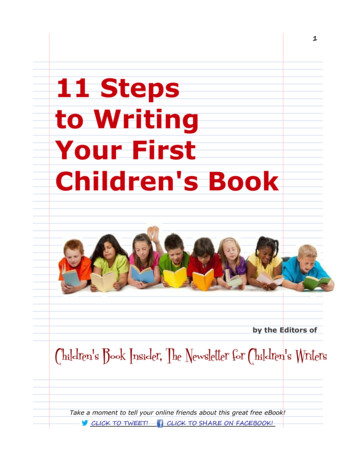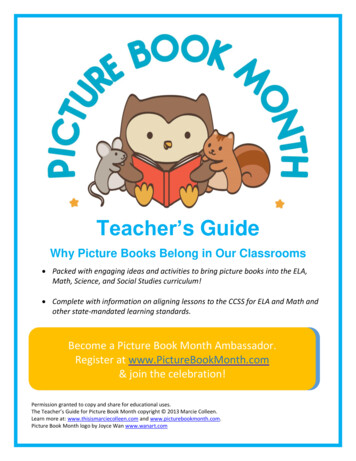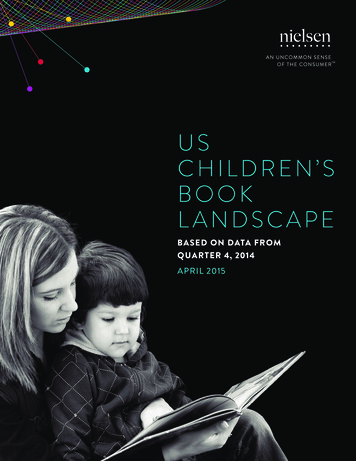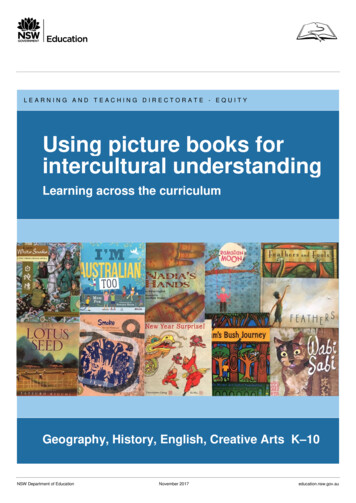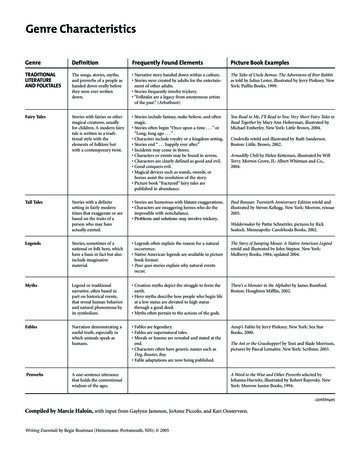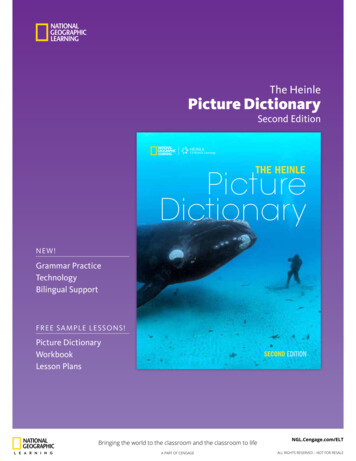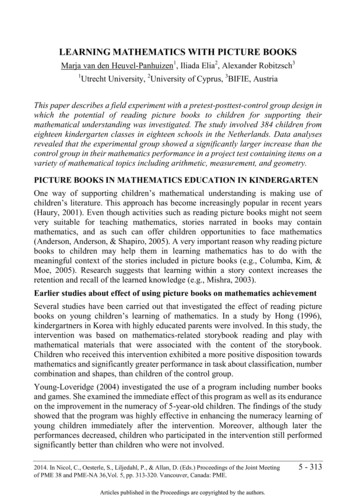
Transcription
LEARNING MATHEMATICS WITH PICTURE BOOKSMarja van den Heuvel-Panhuizen1, Iliada Elia2, Alexander Robitzsch31Utrecht University, 2University of Cyprus, 3BIFIE, AustriaThis paper describes a field experiment with a pretest-posttest-control group design inwhich the potential of reading picture books to children for supporting theirmathematical understanding was investigated. The study involved 384 children fromeighteen kindergarten classes in eighteen schools in the Netherlands. Data analysesrevealed that the experimental group showed a significantly larger increase than thecontrol group in their mathematics performance in a project test containing items on avariety of mathematical topics including arithmetic, measurement, and geometry.PICTURE BOOKS IN MATHEMATICS EDUCATION IN KINDERGARTENOne way of supporting children’s mathematical understanding is making use ofchildren’s literature. This approach has become increasingly popular in recent years(Haury, 2001). Even though activities such as reading picture books might not seemvery suitable for teaching mathematics, stories narrated in books may containmathematics, and as such can offer children opportunities to face mathematics(Anderson, Anderson, & Shapiro, 2005). A very important reason why reading picturebooks to children may help them in learning mathematics has to do with themeaningful context of the stories included in picture books (e.g., Columba, Kim, &Moe, 2005). Research suggests that learning within a story context increases theretention and recall of the learned knowledge (e.g., Mishra, 2003).Earlier studies about effect of using picture books on mathematics achievementSeveral studies have been carried out that investigated the effect of reading picturebooks on young children’s learning of mathematics. In a study by Hong (1996),kindergartners in Korea with highly educated parents were involved. In this study, theintervention was based on mathematics-related storybook reading and play withmathematical materials that were associated with the content of the storybook.Children who received this intervention exhibited a more positive disposition towardsmathematics and significantly greater performance in task about classification, numbercombination and shapes, than children of the control group.Young-Loveridge (2004) investigated the use of a program including number booksand games. She examined the immediate effect of this program as well as its enduranceon the improvement in the numeracy of 5-year-old children. The findings of the studyshowed that the program was highly effective in enhancing the numeracy learning ofyoung children immediately after the intervention. Moreover, although later theperformances decreased, children who participated in the intervention still performedsignificantly better than children who were not involved.2014. In Nicol, C., Oesterle, S., Liljedahl, P., & Allan, D. (Eds.) Proceedings of the Joint Meetingof PME 38 and PME-NA 36,Vol. 5, pp. 313-320. Vancouver, Canada: PME.5 - 313
van den Heuvel-Panhuizen, Elia, RobitzschFurthermore, the findings of a study by Casey, Erkut, Ceder, & Mercer Young (2008),which included storytelling instead of story book reading, gave evidence for theadvantages of using a storytelling context as a means for improving early geometrylearning in children.A common characteristic of all aforementioned studies is that the book reading orstorytelling sessions in class were always combined with other activities such asplaying with story-related (mathematical) materials (Hong, 1996; Young-Loveridge,2004), singing mathematical rhymes (Young-Loveridge, 2004) or composinggeometrical puzzles (Casey et al., 2008).The present studyThe present study is meant to gain more knowledge about the effect of the bookreading itself, i.e., without inclusion of additional (book-related) mathematicalactivities. The study was carried out in the Netherlands and was part of the PICO-maproject (PIcture books and COncept development MAthematics).Our research question was: Can an intervention involving picture book readingcontribute to children’s mathematics performance? Based on earlier research, ourprediction was that kindergartners’ performance in a mathematics test would increasedue to the picture book reading program, i.e., we hypothesized a positive interventioneffect.METHODTo investigate the effect of reading picture books on young children’s mathematicsperformance, a field experiment was carried out in kindergarten classes based on apretest-posttest-control-group design with a three-month picture book reading programas an intervention in which each week two books were read in class to the children.ParticipantsOur sample was based on a stratified sampling procedure resulting in pairs of schoolsthat were approximately similar regarding urbanization level, school size and averageSES of their children. The schools in each pair were assigned randomly to theexperimental group or the control group. In total we had 384 four- to-six-year-oldkindergartners participating in our study: 199 in the experimental group and 185 in thecontrol group. Both groups were quite similar. They had about the same average classsize, proportions of children in Kindergarten year 1 and Kindergarten year 2,proportions of girls and boys, of children with non-Dutch and Dutch home language,and also the children’s age did not differ between the experimental and the controlgroup. The same is true for the children’s mathematics and language abilities asmeasured by the Cito mathematics test and the Cito language test before theintervention took place.The used picture books and reading guidelinesThe reading program used in the intervention consisted of 24 trade books of highliterary quality which have mathematics-related content. Yet, the authors did not5 - 314PME 2014
van den Heuvel-Panhuizen, Elia, Robitzschinclude this content purposely to teach children mathematics. To cover a rich variety ofmathematical domains, we chose picture books dealing with arithmetic, measurement,or geometry. Within these domains we focused respectively on numbers and numberrelations, growth and perspective. Altogether, eight books were selected within eachdomain on the basis of their learning-supportive characteristics (Van denHeuvel-Panhuizen & Elia, 2012).For each book a reading guideline was developed that explains how to read the book.In general, the reading guidelines requested the teachers to maintain a reserved attitudeand not to take each aspect of the story as a starting point for a class discussion, sincelengthy or frequent intermissions could break the flow of being in the story andconsequently diminish the book’s own power to contribute to the mathematicaldevelopment of the children. To promote the children’s mathematical thinking theteachers were suggested to show behavior such as (1) asking oneself a question outloud about the mathematics, (2) playing dumb, or (3) just showing an inquiringexpression at a certain page of a book.Figure 1: Page 4 of the book Feodoor has seven sisters1Figure 1 shows page 4 from the book Feodoor heeft zeven zussen [Feodoor has sevensisters] (Huiberts & Posthuma (illustrator), 2006), which is about a man who has sevensisters. The text on page 3, which is left to page 4, says: “At night before he goes tosleep, he doesn’t get just one kiss. No, his seven sisters give him, altogether twenty-onekisses. Fourteen arms around him, and he is wrapped up well from head to foot. Then,he is read six stories and one poem. Finally, seven fingers reach for the light-switch.”The reading guideline says the teacher to stop after “altogether twenty-one kisses” andto show an inquiring expression by raising her eyebrows. In one of the classes this ledto the following classroom conversation.All children: [All children react together; look at each other; reactions are mumbled.]Teacher:Twenty-one kisses!1 (2006): Gottmer Publishing, Huiberts, M., & Posthuma, S. This material has been copied withpermission of the publisher. Resale or further copying of this material is strictly prohibited.PME 20145 - 315
van den Heuvel-Panhuizen, Elia, RobitzschE:Y:All children:M:Y:Teacher:All children:All children:All children:All children:All children:All children:Y:Teacher:All children:Teacher:E:[Starts counting while tapping her cheek] 3, 4, 5On two sides[All children react to what Y says; only the word ‘two’ can be made out][Says something inaudible to the teacher]. plus 13?No, he received twenty-one kisses, and you just said [she looks at Y] hegets a kiss on each side from every sister, right [teacher points at the firstsister in the picture in the book] because you were already starting to count.You said 2.[The teacher points at the second sister] 4[The teacher points at the third sister] 6[The teacher points at the fourth sister] 8[The teacher points at the fifth sister] 10[The teacher points at the sixth sister] 12[The teacher points at the seventh sister; children hesitate][Starts, doesn’t finish the word] Thir.F.14Fourteen, but then it’s not right. They say twenty-one kisses.Okay, then it’s here, here and here [points at her own face to show wherethe kisses are placed; one on the left cheek, one on the right cheek, and oneon the forehead.]Then, the teacher invited all children to check whether this is correct by giving Feodoorthe kisses as child E suggested. Indeed, then they ended up with twenty-one kisses. Allchildren shouted that Feodoor got three kisses from each of his sisters. This is quite anachievement for a group of kindergartners who have not yet been taught multiplicationor division.The PICO testTo investigate the effect of the picture book reading program we developed theso-called PICO test consisting of multiple-choice items for the domains of arithmetic(including the topics number and number relations), measurement (with the topic oflength with emphasis on growth), and geometry (addressing the topic of perspective).Every item covers one page and contains an illustration depicting a situation and foursmall illustrations that represent the possible answers. After the test instruction of anitem was read aloud to them, the children had to answer it by underlining the correctanswer. Figure 2 shows two items for the domain of arithmetic.The PICO test was administered as a pretest before the intervention took place and as aposttest afterwards. At the same time points the PICO test was also administered in thecontrol classes. At the start of the project, the teachers of these classes were not5 - 316PME 2014
van den Heuvel-Panhuizen, Elia, Robitzschinformed about the aim of the study. The teachers were just told that a test would beadministered at two time points to gain information about how kindergarten’sunderstanding of mathematics grows over a three-month period in normal schoolpractice.MittensShoe boxesTest instruction:These children have cold hands. They all liketo put on the warm mittens. Underline theamount of mittens they need in total.Test instruction:Two shoes fit into one box. How many boxesare needed for the other shoes? Underline thenumber of boxes you need for the other shoes.Figure 2: Two PICO test itemsThe initial version of the test consisted of 42 items. After calculating the itemdiscrimination based on the pretest data, we removed two items which had negativeitem discriminations. This led to a test with 40 items in total that all have a positivecorrelation with the total score. The calculation of the Cronbach’s alpha of this finalversion of the test resulted in a sufficient reliability of α .79 for the whole sample, andα .71 for the sample of K1 children as well as for the sample of K2 children.Furthermore, within the experimental and the control group, we found correlationsbetween the PICO pretest and posttest score ranging from .62 to .83, indicating a hightest stability.To further investigate the properties of the items in the PICO test, we conducted aconfirmatory factor analysis at the item level (using WLSMV estimation implementedin Mplus; Muthén & Muthén, 2007) with the three mathematical topics number andnumber relations, growth, and perspective as dimensions. Due to very largecorrelations between these dimensions, we treated the test as essentiallyone-dimensional. Coherent with these findings, a one-dimensional factor analysisresulted in an almost equally well-fitting model (CFI .96, TLI .97, RMSEA .02).Therefore, we used the total score of the PICO test for analyzing the interventioneffect.Statistical analysisWe investigated the intervention effect by using two linear regression models, namelyOne-Way ANCOVA models. In Model 1, we used the PICO posttest score as adependent variable and as independent variables the experimental group (as a dummyvariable) and the PICO pretest score (as a covariate). In Model 2, further covariatesPME 20145 - 317
van den Heuvel-Panhuizen, Elia, Robitzschwere added, including kindergarten year, age, gender, home language, SES, and Citomathematics and Cito language.Despite the nested structure of the data – children belonging to classes which belong toschools – we applied a single-level linear regression model, because our unit ofinference was at the level of children. Moreover, our clustered sampling procedure inwhich matched pairs of schools were randomly assigned to either the experimental orthe control group decreased the standard errors of the parameters of interest. Yet, to besure about using a single-level linear regression model, we calculated the residualintra-class correlation of the PICO posttest score controlling for the pretest score bymeans of a multilevel random intercept model in lme4 (Bates et al., 2013). It turned outthat the residual intra-class correlation was .025. This finding supported the conclusionthat ignoring the multilevel structure in our analyses did not lead to notableunderestimation of standard errors (Hox, 2010).RESULTSIn Table 1 the descriptives are presented of the PICO test total scores in the pretest andposttest for the whole sample and specified for the experimental and control group, andfor the two kindergarten years. For the PICO pretest score no differences betweenexperimental and control group were found. For the PICO posttest score theexperimental group scored slightly, but not significantly higher than the control group.KindergartenyearK1K2K1 K2Total xperimentalControlN8466115119199185384Pretest score(total items: 40;max. score: 40)MSD d14.0 5.5.0813.6 4.020.2 4.8.0220.1 5.117.5 6.0-.0317.7 5.717.6 5.8p.59.92.74Posttest score(total items: 40;max. score: 40)MSD d18.2 6.0.2516.9 4.524.6 5.3.1923.6 5.421.9 6.4.1121.2 6.021.6 6.2p.11.17.26Table 1: Descriptives for PICO pretest and posttestTable 2 shows the results of the two regression models we used for investigating theintervention effect on the PICO posttest score. Both models gave comparable results.Model 1, in which we had only the PICO pretest score as a covariate, revealed asignificant intervention effect (B .90, p .01), while Model 2, in which we controlledfor seven additional covariates, resulted in a similar intervention effect (B .76, p .02). In this model, pretest, home language and Cito mathematics did have a significantinfluence on the PICO posttest score. Due to space limitations further analyses of theintervention effects in subgroups and the differential intervention effects betweensubgroups cannot be discussed here.5 - 318PME 2014
van den Heuvel-Panhuizen, Elia, RobitzschInterventionPICO pretest bModel 1Ba SE.90 .36.89 .03R² (Explained variance)p β.01 .01.00 .84InterventionPICO pretest bKindergarten year (K2)cAgeGender (girl)Home language (Dutch)SES (medium/high)Cito mathematicsCito languageModel 2BaSE.76.37.69.05.32.67.05.04-.10 .351.22 44.73β.06.64.02.06-.01.07.01.16.05B: unstandardized regression coefficient of the intervention effect; SE: standard error of B; β:standardized regression coefficient.aBecause we expected a positive influence of the picture book reading program the B value forthe intervention effect was tested in a one-tailed way.bBecause the covariates were only treated as control variables, the significance of the B valuewas tested in a two-tailed way.cFor the categorical covariates the dummy variables are placed in parentheses.Table 2: Intervention effect on PICO posttest scoreWhen calculating the effect size d by dividing the B-values by the standard deviationof the PICO pretest scores, we found for Model 1 d .16 (B .90 divided by 5.8) andfor Model 2 d .13 (B .76 divided by 5.8). Comparing these effect sizes with theeffect size of the change from pretest to posttest in the control group (gain score: M 3.5, SD 3.5, d .60, p .00), we found that the influence of the intervention wassubstantial. In Model 1, the change in the experimental group was 27% (.16/.60 .27)larger than the change in the control group and in Model 2, the change was 22%(.13/.60 .22) larger.CONCLUDING REMARKSOur study showed that a three-month picture book reading program with picture bookscontaining mathematics-related content, had a positive effect on kindergartners’mathematics performance as measured by the PICO test. Moreover, these positiveresults were found based on picture book reading without additional mathematicalactivities. In fact, this gain from a short program is quite a lot taking into account thespurt in cognitive growth children generally make at this age, which is clearly shownby the increase in performance of the children in the control group, and which is alsoemphasized by other authors (e.g., Bowman, Donovan, & Burns, 2000). In sum, wecan conclude that our study provided evidence for giving picture book reading asignificant place in the kindergarten curriculum for supporting children’smathematical development.However, this evidence should be considered with prudence. The participation ofschools and teachers was on a voluntary basis which might have caused that onlyPME 20145 - 319
van den Heuvel-Panhuizen, Elia, Robitzschmotivated teachers were involved in the study. Another shortcoming of the study wasthat despite of classroom visits and teachers’ logs we could not completely control theimplementation of the picture book program and also not what the teachers did asregular mathematics-related activities. Therefore, we cannot be absolutely sure that thepicture book reading program as intended was responsible for the effect. Furtherresearch should go more in detail at the micro-level of the classroom conversationsduring the book reading sessions. This would also provide opportunities to identify thespecific effective elements of picture book reading that contribute to the mathematicalunderstanding of kindergartners.ReferencesAnderson, A., Anderson, J., & Shapiro, J. (2005). Supporting multiple literacies: Parents’ andchildren’s mathematical talk within storybook reading. Mathematics Education ResearchJournal, 16(3), 5-26.Bates, D., Maechler, M., Bolker, B., & Walker, S. (2013). lme4: Linear mixed-effects modelsusing Eigen and S4 (R package version 1.0-5) [software]. Available fromhttp://CRAN.R-project.org/package lme4Bowman, B., Donovan, M. S., & Burns, S. (Eds.). (2000). Eager to learn. Educating ourpreschoolers. Washington, DC: National Academy Press.Casey, B., Erkut, S., Ceder, I., & Mercer Young, J. (2008). Use of a storytelling context toimprove girls’ and boys’ geometry skills in kindergarten. Journal of AppliedDevelopmental Psychology, 29, 29-48.Columba, L., Kim, C. Y., & Moe, A. J. (2005). The power of picture books in teaching math& science. Grades PreK-8. Scottsdale, AZ: Holcomb Hathaway.Haury, D. (2001). Literature-based mathematics in elementary school. Retrieved from ERICdatabase. (ED464807).Hong, H. (1996). Effects of mathematics learning through children’s literature on mathachievement and dispositional outcomes. Early Childhood Research Quarterly, 11,477-494.Hox, J. (2010). Multilevel analysis: Techniques and applications. New York: Routledge.Huiberts, M., & Posthuma, S. (illustrator) (2006). Feodoor heeft zeven zussen [Feodoor hasseven sisters]. Haarlem, The Netherlands: Gottmer.Mishra, A. (2003). Age and school related differences in recall of verbal items in a storycontext. Social Science International, 19, 12-18.Muthén, L. K., & Muthén, B. O. (2007). Mplus user’s guide (5th ed.). Los Angeles, CA:Muthén & Muthén.Van den Heuvel-Panhuizen, M., & Elia, I. (2012). Developing a framework for the evaluationof picturebooks that support kindergartners’ learning of mathematics. Research inMathematics Education, 14(1), 17-47.Young-Loveridge, J. M. (2004). Effects on early numeracy of a program using number booksand games. Early Childhood Research Quarterly, 19, 82-98.5 - 320PME 2014
mathematics, and as such can offer children opportunities to face mathematics (Anderson, Anderson, & Shapiro, 2005). A very important reason why reading picture books to children may help them in learning mathematics has to do with the meaningful context of the stories included in
